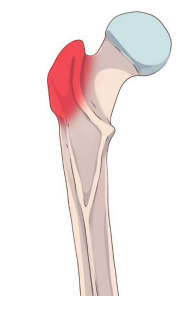A hip pointer is a contusion (bruise) to the iliac crest, the surrounding soft tissue or the greater trochanter of the femur. Typically, there tends to be a small amount of fatty tissue making this area more susceptible to injury from direct impact trauma of a fall. Impact to the hip leads to a hematoma around the area. Often, bleeding into abductor muscle creates increased tenderness in the area and results in decreased range of motion in the hip due to pain and swelling. However, hip flexors and motor strength will remain intact. Patients with a hip pointer are at risk for recurrent injury.
A hip pointer can occur in both contact sports (football, rugby, hockey, and basketball) or non-contact sports (volleyball) as a result of a fall onto the side of the hip. The pain and tenderness on the side of the hip can be debilitating. Other signs and symptoms include the following: a sudden onset of hip pain in the iliac crest or greater trochanter regions after a fall or hit to the area; the presence of swelling and burning; decreased hip range of motion (ROM) at the hip and abdominal area; and a limp when the patient walks. If you suspect you or someone else has experienced a hip pointer, follow-up with your physician or general practitioner for a physical exam, X-rays of the hip to rule out fractures, and a computer topography (CT) scan if pain continues in order to assess soft tissue for a definitive diagnosis.
Standard Treatment For A Hip Pointer
Standard treatment for a hip pointer includes ice packs to the affected side, NSAIDs for pain and swelling, and rest of the affected hip until symptoms improve. Once pain decreases in the affected side of the hip, ROM and activity will increase. At this time physical therapy (PT), including stretching and walking as tolerated, will begin. As pain and swelling continue to lessen and normal ROM function improves, patients may return to physical activity. Most injuries improve with non-operative treatment. Still, if pain persists for over 2 weeks, an orthopedic consult may be necessary.

References
Lombardi, N. J., Tucker, B., Freedman, K. B., Austin, L. S., Eck, B., Pepe, M., & Tjoumakaris, F. P. (2016).
Accuracy of Athletic Trainer and Physician Diagnoses in Sports Medicine. Orthopedics, 39(5), e944–e949.
https://doi.org/10.3928/01477447-20160623-10.
Marta, T. (2021). [Diagram]. Greater trochanter . The femur, or thigh bone, is the proximal bone of the
hindlimb in tetrapod vertebrate, the largest bone of the human body. https://www.shutterstock.com/
image-illustration/greater-trochanter-femur-thigh-bone-proximal-1864502293.
Martinez, J. (2021). Hip Pointer. https://emedicine.medscape.com/article/87322-followup.
